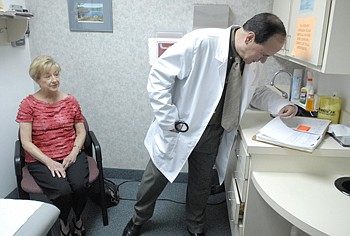A Dalton, Ga., physician who lobbied to pass medical malpractice reform in 2005 is disappointed by the Georgia Supreme Court ruling that overturned the law.
"We've really put ourselves back to where we may be facing a physician shortage as time goes on and Georgia will be a less hospitable place for people to come and practice medicine," said Dr. John Antalis of Dalton Family Medicine.
The past president of the Medical Association of Georgia and Dalton district director for the group said, "It is going to put more pressure on the delivery of health care in our state and that's a sad situation."
But others hail as a victory for patients' rights last month's decision overturning a cap on noneconomic damages in malpractice cases.
"The ruling favored our individual rights over heavy-handed government intervention in the courtroom," said Danny Orrock, deputy director of Georgia Watch, a consumer watchdog group based in Atlanta.
The Georgia Supreme Court ruled unanimously that the state Legislature could not limit the amount awarded by juries in medical malpractice cases. The case involved a woman disfigured by a cosmetic surgery procedure.
The decision also overturned a 2005 malpractice reform law that capped noneconomic damages, such as pain and suffering, at $350,000 in most cases.
The court stated that the law was unconstitutional in that it infringed upon citizens' right to a trial by jury.
Malpractice attorney Erik Olson, owner of Olson Law Firm in Atlanta, agrees.
"We trust 12 people in a jury box to sentence a man to death or to spare their life, but we don't trust that same jury to decide what proper damages are? That doesn't make any sense," he said.
IMPACT DEBATED
PDF: Georgia Supreme Court decisionMALPRACTICE INSURANCE RATESMAG Mutual, a physician-owned insurance company based in Georgia, insures more than 50 percent of physicians in Georgia. Average premiums in 2009:* Internal medicine -- $12,911* General surgery -- $43,904* OB/GYN -- $64,884Source: Georgia Department of Insurance, Medical Liability Monitor newsletterCHANGING MALPRACTICE RATESThe average price of malpractice insurance in Georgia doubled between 2000 and 2005, said Darrell Grimes, president of MAG Mutual Insurance Co. But since the reforms went into effect, premiums have declined by 18 percent, and likely would have declined further had the state Supreme Court upheld the 2005 reforms, he said.
The ruling came as a letdown to many doctors. They say that the limits helped reduce premiums for liability insurance, making the state more attractive for new physicians.
More malpractice insurance companies also have started operating here, increasing competition and options for physicians, Dr. Antalis said.
Experts debate how much impact tort reform really can have on overall health care spending. They say the cost of liability insurance and payouts to patients from court cases are a small fraction of the $2.5 trillion in annual health care spending.
During the national health care reform debate, doctors lobbied heavily for comprehensive tort reform, which they said would help rein incosts.
Congressional Budget Office estimates released in October said tort reform would reduce health care spending by 0.5 percent, or about $11 billion in 2009, and would reduce the federal deficit by $54 billion over 10 years.
But that estimate was based on reforms including a cap of $250,000 on noneconomic damages, a cap on punitive damages of $500,000 or twice the award for economic damages, and statutes of limitations for bringing cases.
The final reform package only allocates some grant funding for "demonstration projects" to try out alternative tort reforms in various states, according to the Kaiser Family Foundation, an advocacy group for better health care.
PLAYING DEFENSE
Doctors say the real wasteful spending comes from the practice of "defensive medicine," in which they run extra scans and tests for fear of being accused of negligence.
Cost estimates for such practices have ranged from $60 billion to nearly $200 billion a year from libertarian research group Pacific Research Institute.
"When you step back and look at the total picture, I think it absolutely drives the cost of health care," said Dr. Joel Williams, a Dalton-based plastic surgeon.
"I don't think you're going to talk to many physicians that are going to say, 'People that are wronged should be abandoned,'" he said. "However, if you look at the percentage of medical malpractice suits that actually end up in victory or a payout to the person, it's pretty small."
He said reasonable limits to noneconomic damages -- not awards that cover medical expenses or losses in income -- can deter trial lawyers from pursuing groundless suits.
Thirty states impose caps on jury awards in malpractice cases, according to the National Conference of State Legislatures. In Tennessee, reforms passed in 2008 did not cap damages but added a certification process aimed at weeding out frivolous lawsuits, according to the Tennessee Medical Association.
